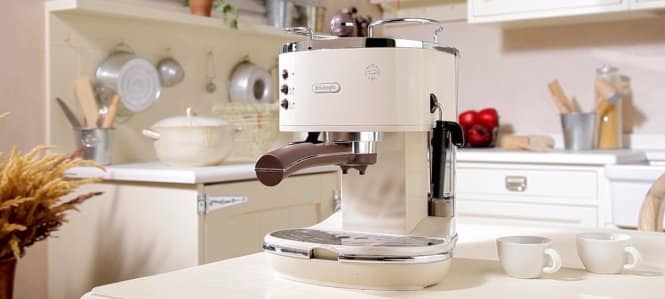Espresso coffee and the machines that produce it deserve an encyclopedia of their own, since the variables and the types of devices available for sure will surpass the length of this article and its intention. However, we will attempt to summarize their strongest points by focusing on one type of machine at a time. Firstly, we will discuss the pump-driven machine.
What an espresso machine basically does is forcing pressurized water close to the boiling point through some freshly ground coffee (or as it is known in the coffee community, a “puck”) and a filter. A cup of espresso is a cup of thick, concentrated and robust coffee. The first machine goes back to the XIX century and finds its home in Turin, Italy. As we previously established, there are several machine designs that have been specifically built to brew this type of coffee; one of them being the pump-driven one.
This is a modern machine and has become, since its introduction in the 60’s, the most popular one in the commercial espresso bars demographic. This machine doesn’t require manual force. A pump powered by a motor provides the necessary force that the brewing requires. These machines accept water directly from the line, meaning the water will be cold and it’s the machine the one in charge of the heating.
The Chemex is a whole different story. While the pump-driven espresso machine is a commercial device and not one that can easily be found in a private residence, the Chemex is the opposite. Is a device with a limited capacity since the vessel where the coffee is poured is a part of the device itself, and uses a pour over method. This means that, in contrast to the espresso machine, the Chemex requires a vast amount of user interaction, where the water must be heated, the filter and the coffee put in place, and so on. Every step in the Chemex brewing process involves the user, whereas the espresso machine is vastly automatic.
Comparing these two devices and the subsequent coffee they are capable of brewing is like doing so with water and oil. They are radically different and made with very specific requirements in mind. The espresso machine produces espresso, a coffee that is drank in small proportions due to how concentrated and strong it is; it is mainly used in bars and commercial places because of its quickness and particularities. This machine was not designed for homely use. The Chemex is a classic pour over method that has the advantage of a greatly designed vessel that is included in the overall device, separating itself from ceramic or plastic equipment that are not so practical or beautiful.
As opposed to other articles where the comparisons are minimal, in this case there is not a lot in common. Being as these two are so vastly different, there is no real need to make a choice. Espresso is perfect for outings and enjoying once in a while, but when it comes to home-made coffee, prepared to fit your particular taste, the Chemex has few contenders that are up to par.
